#dog bites
Explore tagged Tumblr posts
Text
Here is the bite I got breaking up a fight between two of our dogs
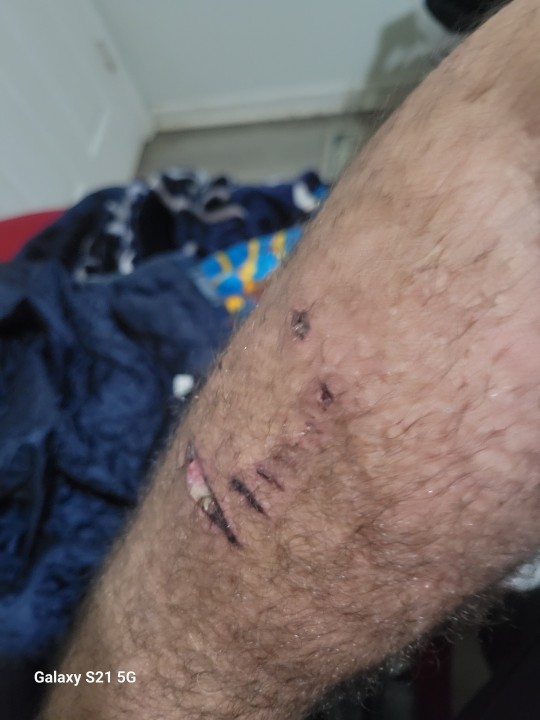
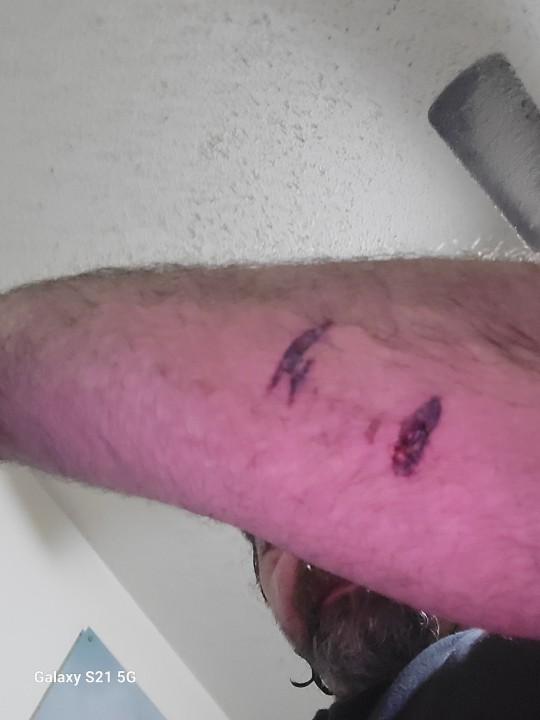
And here is the dummy that bit me. His name is Odie. He's a blockhead, but I still love him.
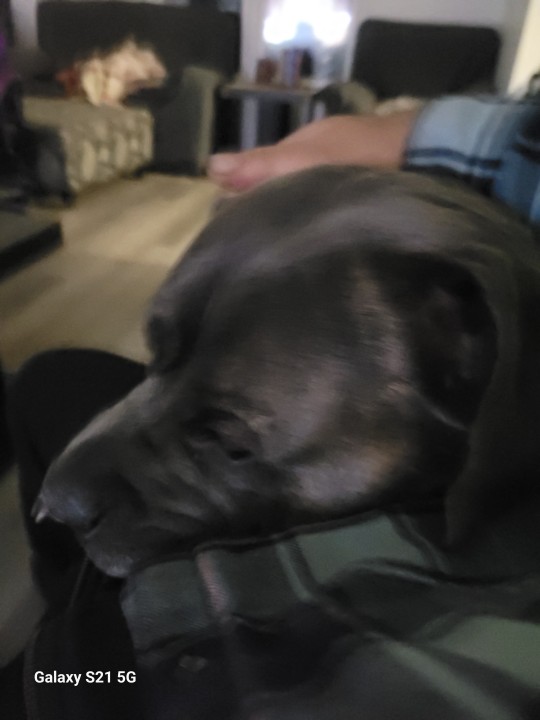
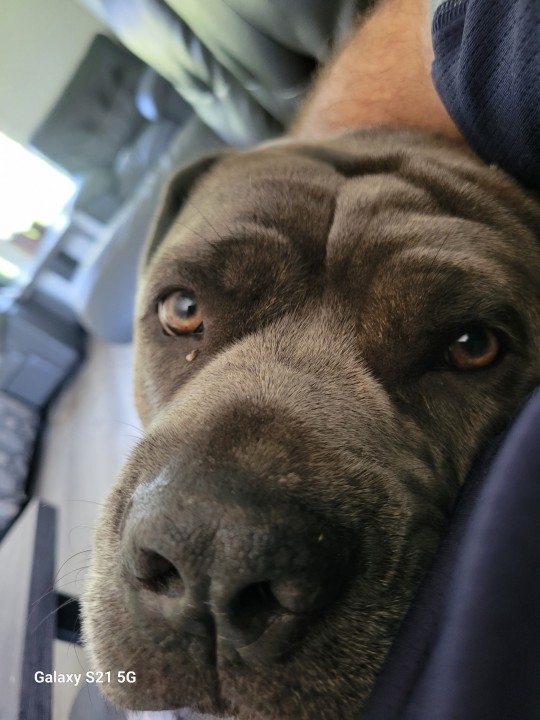
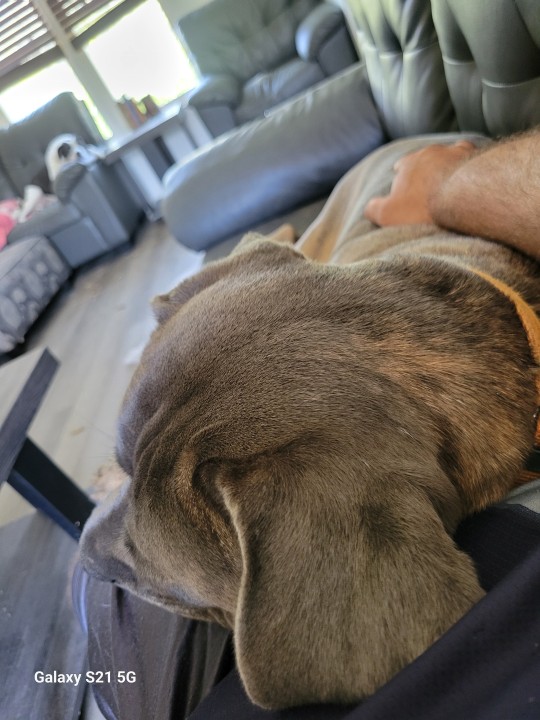
4 notes
·
View notes
Text

So this is maggie. I have been crying for the last hour. She was shot 17 times, her eyes and ear were ripped out. She was also pregnant and her former owners tied her to a box waiting for her to die. It is impossible for me to express the contempt I have for people not only who hurt living beings in this way, but also for people who, under the pretext of "things like that have always happened" or "That doesn't suit me." '' allow it to pass. It is not an excuse. It is a form of self-consolation because they know that passing them by is wrong. But they keep doing it.
Many people will say that I care more about animals than people. What's more, those around me have told me this on several occasions and let me assure you that nothing could be further from the truth. But seeing how helpless most dogs are when they are inherited, it breaks my heart. They depend on us, and abandoning them, hitting them and mistreating them is a complete abuse of power and shows what a tremendous piece of shit people can be. It's like, you don't hit a baby. Never. They are helpless and depend on us. Many people have also told me that many dogs are not harmless and bite and hurt people. It's true, yes. I'm not going to deny it: Remember what happened to poor Jacqueline Durant. but let's remember that dogs have instincts. I do not support dogs attacking humans, nor do I approve of humans mistreating dogs in such degrading ways.
So this is why, if you can and just if you can, i incite you to donate to help this people and also animals.
If you want to and you can, please do it. If you want to but you cant, it's okay.
If you dont want to and you can, please think about the kind of person you are. like , for real, what the fuck. Look at photos of Jacqueline durant and think about it, Look at those heartbreaking rescuing dogs videos and think about it. Help one of these to gruops. I dont care, please.
People who suffered similar injuries than her need help. Dogs like maggie need help.
We need to react. Nothing's gonna change if we dont do anything.
#dogs#animal rescue#dog rescue#rescue cats#animals#everyone.#crying because im just sad#also help humans#dog bites#help animals
5 notes
·
View notes
Text

#Airbag Injuries#Amputation Injuries#Assault and Battery#Auto Accidents#Aviation Accidents#Birth Injuries#Bicycle Accidents#Bus Accidents#Burn Injuries#Car Accidents#Cat Bites#Dog Bites#Drunk Driving Accidents#Escalator Accidents#Elevator Accidents#Hospital Acquired Infections (HAI)#Liquor Liability/Dram Shops#Medical Malpractice#Motorcycle Accidents#Nursing Home Abuse#Premises Liability#Product Liability#PTSD Injuries#Swimming Pool Accidents#Slip and Falls#Spinal Cord Injuries#Traffic Collisions#Train Accidents#Traumatic Brain Injuries#Truck Accidents
2 notes
·
View notes
Text

For #KernerBabygirl Project on TWITTER (im not gonna accept that ugly X shwit)
Do you guys know that Ron Kerner has two kitties🐈⬛🐈⬛❤️❤️
But can a doggo stay with two cats?
Well…
If they bite him
You’ll see he bite back
🐕🐈⬛🐈⬛❤️
#top gun fandom#top gun fanart#fanart#top gun#pete maverick mitchell#pete mitchell#ron slider kerner#top gun 1986#slider top gun#top gun slider#charles chipper piper#top gun chipper#bites#dog bites#kitty
9 notes
·
View notes
Text

Some people describe a police dog’s bite as a deep tear through their flesh. Others are haunted by the feeling of a Vise-Grip, the dog's jaws slowly but painfully tightening around their arms or legs until the muscles go numb.
These are not the nips or snaps of a pet dog in a backyard. A police dog, trained for weeks on how to bite harder and faster and with little reservation, can inflict debilitating injuries and lasting scars. The physical damage lingers as long as the memories of a dog’s snarling teeth, its guttural growls, its head ripping back and forth upon crashing into a fleeing target, all while a police officer stands nearby shouting commands and praise in German, Dutch or Czech.
Across the nation, police dogs bite thousands of people a year. And in no major city is someone more likely to be bitten than in Indianapolis.
The Indianapolis Metropolitan Police Department, home to one of the largest K-9 units in the country, has the highest rate of dog bites among police departments in the largest 20 U.S. cities.
Some cities saw one police dog bite over the last three years. In Indianapolis, it was once every five days.
Law enforcement officers from around the United States train with their police dogs on how to capture a suspect at Vohne Liche Kennels, in Indiana, on Sept. 23, 2020. Dogs are muzzled for the protection of the man acting as a decoy, who is not wearing typical bite gear for this training exercise.Mykal McEldowney/IndyStar
Those are just some of the findings of a yearlong investigation by IndyStar and the Invisible Institute in Chicago, along with The Marshall Project, and AL.com.
The first-of-its-kind national analysis included a review of police dog bites from 2017-19. That review found that IMPD dogs bit 243 people over those three years. That’s more bites than New York; Chicago; Philadelphia; San Antonio; Dallas; Austin; San Francisco; Fort Worth; Columbus; Seattle; and Washington, D.C.
Combined.
Police K-9 Bites per 100,000 Residents
Among police departments in the 20 largest cities, some have much higher rates of police dog bites than others. Between 2017 and 2019, Indianapolis Metropolitan Police dogs had 243 bites, or about 28 bites per 100,000 residents. But city police in Chicago, Philadelphia and San Francisco each recorded only one incident.

Source: Analysis of use of force data from police departments, population data from the Census Bureau.
Per-capita rates use the latest five-year census population estimates and are approximations. City police departments in Los Angeles, Houston and San Antonio may include serious non-bite injuries in their K-9 use of force records. Charlotte-Mecklenburg Police Department data for bites in 2019 include numbers through January 23, 2020.
The investigation also revealed for the first time:
Nearly 60 percent of people who had been bitten in Indianapolis were suspected in only low-level and non-violent crimes or traffic infractions; bites that would appear to be out of policy in some other cities, such as Seattle and Washington, D.C.
At least 65 percent of those bitten were unarmed and did not act violently, facts that contradict IMPD’s stated reasons for using dogs so often.
More than half of the people who were bitten are Black, a disproportionately high number for a population that makes up just 28 percent of the city.
15 percent of people bitten were younger than 18. Three-fourths of the juveniles are Black.
Sometimes police dogs bite the wrong people entirely, such as police officers at a crime scene or innocent bystanders in a neighborhood.
Marshawn Wolley, a community leader who has worked alongside Indianapolis city and police leadership to reform IMPD’s policies, said he was shocked to learn about what’s happening with IMPD’s dogs.
"This is not meeting the standards of what we expect from a professional police department. They have missed the mark. Dramatically,” Wolley said. “There’s really no hiding from this. They set the standard for being the worst. This has to be addressed. This has to be addressed."
Indianapolis Mayor Joe Hogsett declined an interview request. He answered questions by email.
"These numbers are clear evidence that we must continue to have a dialogue with our community around what they expect not just of the K-9 unit," Hogsett said via email, “but of their police department as a whole."
The high number of bites in Indianapolis is driven in part by the convergence of two factors: a comparably loose set of IMPD policies that enables K-9 officers to release their dogs on people suspected of committing low-level offenses and, critics say, an old-school policing culture that encourages officers to do just that.
When IndyStar presented its findings to IMPD Chief Randal Taylor this month, he said he was concerned about the numbers.
"You know, I would hope we wouldn't have to bite that often," Taylor said. "If there's changes we need to make, I'm always for that."
Then, in an email Oct. 7, Taylor announced his department had drafted a new policy that, he says, will eventually place restrictions on the use of police dogs. For example: Officers would no longer deploy dogs on suspects in misdemeanor cases unless they believed that person is armed, though dogs would still be justified in all felony cases.
The policy change, if enacted, would have stripped out as many as 23 bites in misdemeanor cases over the last three years—an amount larger than the total number of bites found in some major cities.
That said, it's just 10 percent of the bites in Indianapolis. Even if they were removed from IMPD's total, Indianapolis would still remain the major city where someone is most likely to be bitten by a police dog.
#The City Where Someone Was Bitten by a Police Dog Every 5 Days#dog bites#k9 weaponized#cops and dogs#indianapolis#indiana#police dogs biting citizens#police dogs weaponized against citizens
5 notes
·
View notes
Text
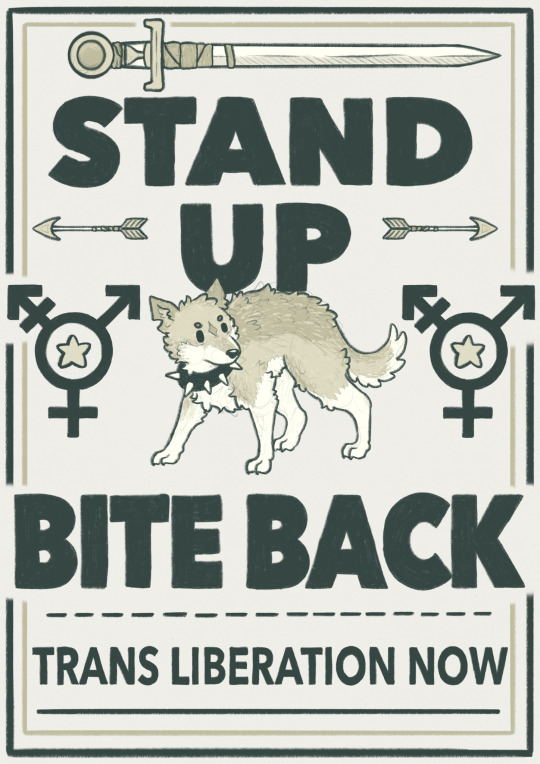
⚔️
#art#illustration#artists on tumblr#comics#doodle#illustrator#artist#digital art#animal art#trans rights#protest art#trans art#trans pride#stand up bite back#trans lives matter#trans liberation#dog art#dog illustration#canine art
9K notes
·
View notes
Text

Crash call Ash! Ashley Injury Lawyers is your powerhouse injury lawyer if you've been injured in an automobile accident, truck or motorcycle accident. We also handle dog bites, slip and falls, catastrophic injuries and wrongful death cases. Ashley wins Millions! We will aggressively fight for you to get your every dollar you deserve. Our lawyers and staff provide compassionate care and legal support to our clients and their families who have been injured or lost a loved one because of another party's negligence. Results You Can Trust. Call 888-ASHLEY-911!
Business Hours: 24/7
Contact Info:
Ashley Injury Lawyers
Address: 7750 College Town Dr #200, Sacramento, CA 95826 USA
Phone: +1 916-419-1111
Mail: [email protected]
Website: https://crashcallash.com/
Find Online:
Facebook: https://www.facebook.com/AshleyInjuryLawyers
Instagram: https://www.instagram.com/ashleyinjurylawyers/
Google Maps CID: https://www.google.com/maps/place/?cid=11969778129610966448
#Personal Injury Attorneys#Injury Attorneys#auto accidents#motorcycle accidents#truck accidents#wrongful death#pedestrian accidents#dog bites#slip and falls#brain injuries#catastrophic injuries and wrongful death cases
1 note
·
View note
Text
Dr. Ian Dunbar’s Dog Bite Scale (Official Authorized Version)
An assessment of the severity of biting problems based on an objective
evaluation of wound pathology
Level 1. Obnoxious or aggressive behavior but no skin-contact by teeth.
Level 2. Skin-contact by teeth but no skin-puncture. However, may be skin nicks (less than one tenth of an inch deep) and slight
bleeding caused by forward or lateral movement of teeth against skin, but no vertical punctures.
Level 3. One to four punctures from a single bite with no puncture deeper than half the length of the dog’s canine teeth. Maybe
lacerations in a single direction, caused by victim pulling hand away, owner pulling dog away, or gravity (little dog jumps, bites and
drops to floor).
Level 4. One to four punctures from a single bite with at least one puncture deeper than half the length of the dog’s canine teeth. May
also have deep bruising around the wound (dog held on for N seconds and bore down) or lacerations in both directions (dog held on
and shook its head from side to side).
Level 5. Multiple-bite incident with at least two Level 4 bites or multiple-attack incident with at least one Level 4 bite in each.
Level 6. Victim dead.
The above list concerns unpleasant behavior and so, to add perspective:
Levels 1 and 2 comprise well over 99% of dog incidents. The dog is certainly not dangerous and more likely to be
fearful, rambunctious, or out of control. Wonderful prognosis. Quickly resolve the problem with basic training (control) —
especially oodles of Classical Conditioning, numerous repetitive Retreat n' Treat, Come/Sit/Food Reward and Back-
up/Approach/Food Reward sequences, progressive desensitization handling exercises, plus numerous bite-inhibition exercises and
games. Hand feed only until resolved; do NOT waste potential food rewards by feeding from a bowl.
Level 3: Prognosis is fair to good, provided that you have owner compliance. However, treatment is both time-consuming and not
without danger. Rigorous bite-inhibition exercises are essential.
Levels 4: The dog has insufficient bite inhibition and is very dangerous. Prognosis is poor because of the difficulty and danger of
trying to teach bite inhibition to an adult hard-biting dog and because absolute owner-compliance is rare. Only work with the dog in
exceptional circumstances, e.g., the owner is a dog professional and has sworn 100% compliance. Make sure the owner signs a form in
triplicate stating that they understand and take full responsibility that: 1. The dog is a Level 4 biter and is likely to cause an equivalent
amount of damage WHEN it bites again (which it most probably will) and should therefore, be confined to the home at all times and
only allowed contact with adult owners. 2. Whenever, children or guests visit the house, the dog should be confined to a single locked-
room or roofed, chain-link run with the only keys kept on a chain around the neck of each adult owner (to prevent children or guests
entering the dog's confinement area.) 3. The dog is muzzled before leaving the house and only leaves the house for visits to a
veterinary clinic. 4. The incidents have all been reported to the relevant authorities — animal control or police. Give the owners one
copy, keep one copy for your files and give one copy to the dog's veterinarian.
Level 5 and 6: The dog is extremely dangerous and mutilates. The dog is simply not safe around people. I recommend euthanasia
because the quality of life is so poor for dogs that have to live out their lives in solitary confinement.
https://apdt.com/wp-content/uploads/2017/01/ian-dunbar-dog-bite-scale.pdf
0 notes
Text


#ordinary photo of yeti#they made astarion in a lab for me to be obsessed with.#like hottest man in game for me is halsin truthfully. astarion is my shitty little white dog with separation anxiety who bites people.#very different things. if i say i'm doing a playthrough as astarion that's when you put me down#main factor motivating me not to is i need to hear neil newbon's voice acting at least once a minute or i die.#i've got a dark urge concept rattling around the brain but i should maybe self-impose a gaming break and take care of. responsibilities 😐#babbling
65K notes
·
View notes
Text
What to Do After a Slip and Fall Accident in Portland
#Airbag Injuries#Amputation Injuries#Assault and Battery#Auto Accidents#Aviation Accidents#Birth Injuries#Bicycle Accidents#Bus Accidents#Burn Injuries#Car Accidents#Cat Bites#Dog Bites#Drunk Driving Accidents#Escalator Accidents#Elevator Accidents#Hospital Acquired Infections (HAI)#Liquor Liability/Dram Shops#Medical Malpractice#Motorcycle Accidents#Nursing Home Abuse#Premises Liability#Product Liability#PTSD Injuries#Swimming Pool Accidents#Slip and Falls#Spinal Cord Injuries#Traffic Collisions#Train Accidents#Traumatic Brain Injuries#Truck Accidents
2 notes
·
View notes
Text
The tiny pink house was pretty much empty. And run-down and dark, since the electricity had been shut off. Nevertheless, someone was trying to burglarize it, a caller told 911 well after midnight on a Sunday in Montgomery, Alabama.
The police called in a K-9 handler and his dog, Niko, to search 3809 Cresta Circle. The dog lunged, found a man and bit down, according to court records. It took almost two minutes for the handler to pull the dog off. And before long, their suspect, a 51-year-old Black man, bled to death. The dog had torn an artery in his groin.
The man was Joseph Lee Pettaway, and his family says he was no burglar. He got in trouble for bad checks and served time years ago, but was now taking care of his 87-year-old mother, Lizzie Mae, and helping to repair the pink house in her neighborhood, they said; he had a key and permission to sleep there.

Joseph Pettaway’s sister, Jacqueline, comforts their mother, Lizzie Mae Pettaway. Joseph died in July of 2018 in Montgomery, Alabama, after being bitten by a police dog.Joe Songer/AL.com
The family is suing the city, seeking damages and information about what happened. “I never thought a dog would end up killing anybody, especially a trained dog,” said Walter Pettaway, Joe’s brother. The family also wants public release of the police bodycam video from July 8, 2018, that is described in court documents.
The city is fighting to keep the video from going public, arguing in court that it would cause “annoyance, embarrassment” for officers who were acting in good faith and could end up “facilitating civil unrest.” Officials did not respond to requests for comment.
Police dog bites are rarely fatal. But in other ways, the case of Joseph Pettaway is not unusual. These dogs, whose jaws and teeth are strong enough to punch through sheet metal, often produce severe injuries. Police employ them not only in emergencies, but also for low-level, non-violent incidents. The dogs bite thousands of Americans each year, including innocent bystanders, police officers, even their own handlers. And there is little oversight, nationally or in the states, of how police departments use them.
These are some of the findings of an investigation by The Marshall Project, with AL.com, IndyStar and the Invisible Institute in Chicago. We obtained dog-bite data from police departments around the country, including the agencies in the 20 largest U.S. cities. Our reporters also examined more than 140 serious cases nationwide, and reviewed thousands of pages of documents, including excessive force lawsuits, department policies, arrest reports and medical studies. We looked at scores of videos of police dog bites. We spoke with victims and their lawyers, law enforcement officials, former and current trainers and other experts.
Here’s more of what we found:
Though our data shows dog bites in nearly every state, some cities use biting dogs far more often than others. Police in Chicago almost never deploy dogs for arrests and had only one incident from 2017 to 2019. Washington had five. Seattle had 23. New York City, where policy limits their use mostly to felony cases, reported 25. By contrast, Indianapolis had more than 220 bites, and Los Angeles reported more than 200 bites or dog-related injuries, while Phoenix had 169. The Sheriff’s Department in Jacksonville, Florida, had 160 bites in this period.
Police dog bites can be more like shark attacks than nips from a family pet, according to experts and medical researchers. A dog chewed on an Indiana man’s neck for 30 seconds, puncturing his trachea and slicing his carotid artery. A dog ripped off an Arizona man’s face. A police dog in California took off a man’s testicle. Dog bites cause more hospital visits than any other use of force by police, according to a 2008 academic analysis of 30 departments.
Many people bitten were unarmed, accused of non-violent crimes or weren't suspects at all. Court records show cases often start as minor incidents—a problem with a license plate, a claim of public urination, a man looking for a lost cat. Although some departments, like Seattle, Oakland, California, and St. Paul, Minnesota, now have strict criteria about when dogs can bite, many continue to give officers wide discretion.
Some dogs won’t stop biting and must be pulled off by a handler, worsening injuries. Although training experts said dogs should release a person after a verbal command, we found dozens of cases where handlers had to yank dogs off, hit them on the head, choke them or use shock collars.
Men are the most common targets of police dog bites—and studies suggest that in some places, victims have been disproportionately Black. Investigations into the police department in Ferguson, Missouri, and the Los Angeles County Sheriff’s Department have both found that dogs bit non-White people almost exclusively. Police dog bites sent roughly 3,600 Americans to emergency rooms every year from 2005 to 2013, according to a recent study published in the Journal of Forensic and Legal Medicine; almost all were male, and Black men were overrepresented.
For many bite victims, there’s little accountability or compensation. Federal civil rights laws don’t typically cover innocent bystanders. In many parts of the country, criminal suspects can’t bring federal claims if they plead guilty or are convicted of a crime related to the biting incident. And even when victims can bring cases, lawyers say they struggle because jurors tend to love police dogs—something they call the Lassie effect.
Police dogs have a highly charged history in the United States, especially in the South, where they were used against enslaved people and, in the 1960s, civil rights protesters.
How Dogs Were Used as Weapons in North America’s History
French colonizers used hundreds of hounds against enslaved people who rebelled during the Haitian Revolution (1791-1804), according to Tyler Parry, assistant professor of African American and African Diaspora Studies at the University of Nevada, and Charlton W. Yingling, Assistant Professor at University of Louisville. An 1805 engraving shows trained bloodhounds attacking a Black Haitian family. Archive Photos/Getty Images
During the Second Seminole War (1835-1842), the United States military used Cuban bloodhounds to force the Seminole Indians from central Florida to west of the Mississippi River, as seen in an 1848 lithograph. MPI/Getty Images
An 1864 engraving by Van Ingen & Snyder depicts an enslaved man protecting his family from bloodhounds. Dogs were used to hunt enslaved people of African descent in the U.S. who had attempted to escape as early as 1790, according to Dr. Parry and Dr. Yingling. AF Fotografie/Alamy
A Black high school student, Walter Gadsden, 15, is attacked by a police dog during a civil rights demonstration in Birmingham, Alabama, in 1963, in this photo by Bill Hudson. These and other iconic images from the Birmingham protests shocked many Americans and helped bring an end to segregation laws. Bill Hudson/Associated Press
Officers brought dogs to the Newark race riots of 1967, which began in response to the beating by police of John Smith, a Black cab driver. An officer with a dog argued with a man on July 14, 1967. Agence France-Presse, via Getty Images
A police dog attacks a Steelers fan during the celebration of the team’s Super Bowl victory in downtown Pittsburgh, Jan. 22, 1979. R.C. Greenawalt/Associated Press
But police departments that use dogs said the K-9s are essential tools for finding fleeing suspects, and for searching dark, narrow spaces for hidden dangers. That makes them crucial for officer safety.
Not every suspect who runs or hides or is not complying with commands will try to injure an officer, said Deputy Chief Josh Barker of the Indianapolis Metropolitan Police Department. But, he said, "In a lot of the instances, we're using that K-9 as a tool because we simply don't know.”
When police use dogs properly, injuries should be minor and require little treatment, handlers, trainers and experts said. The dogs are trained to create puncture wounds, but little else. The wounds should not involve tearing flesh, and the bite shouldn’t last long—seconds, not minutes.
The dogs are “not taught to rip, they’re not taught to tear, they’re not taught to maim,” said Kenneth Licklider, who has been training and selling police dogs for decades. Licklider owns Vohne Liche Kennels in Indiana, which supplies dogs and trains their handlers.

Kenneth Licklider, owner of Vohne Liche Kennels, walks through a hallway in one of the many training buildings at his facility, in Indiana, in September. Licklider, who founded the company in 1993 after retiring from the military, has been training canines for more than 40 years. Mykal McEldowney/IndyStar
And with training and supervision, the dogs bite only a fraction of the times they are used, officials said. That’s a hard statement to prove, because few departments keep standardized data. Many of those that responded to our requests for records did not provide information on deployments, and when they did it was incomplete and inconsistent.
As a spokesman for the Jacksonville sheriff noted, “With policies varying among agencies, the number of engagements cannot be accurately compared.”
But some attorneys said the law should treat police dogs as lethal weapons. “I'd put being attacked by a dog just below being shot,” said Hank Sherrod, who has represented dog bite victims in Alabama.
Law enforcement agencies employ about 15,000 dogs for everything from finding lost children to sniffing out drugs, according to the U.S. Police Canine Association, a professional group. But no countrywide database tracks police dogs, the number of bites or who is bitten. There are no national requirements for dog handlers.
Handling dogs is more art than science, some in the business say. “The handler’s personality will go right down that leash,” said Ernie Burwell, a former canine handler for the Los Angeles County Sheriff who now testifies as an expert witness in excessive force cases. “If the handler’s an idiot, the dog will be, too.”
The lack of regulation worries some experts.
“It’s just sort of the Wild West when it comes to these dogs,” said Christy Lopez, a professor at the Georgetown University Law Center who previously focused on policing and civil rights at the U.S. Department of Justice. She recalled speaking to a young Black teenager in Ferguson, Missouri, who’d been curled up in a closet when a police dog gnawed on his arm.
“In Ferguson, I realized this was not a thing that needed to be reformed,” Lopez said. “It was a thing that needed to end.”
The Police Executive Research Forum, a prominent law enforcement think tank, recently called for clearer national standards to ensure all agencies have protocols for canine use.
Police officers said they are already careful about using dogs.
“A dog bite, it’s a violent encounter,” said Patrick McKean, trainer for the Mobile Police Department in Alabama. “The dog’s hurting somebody. We’re not going to just do that just for any little reason.”
Trainers say bites are worse when people don’t follow orders—when they try to run or fight back. But many videos we reviewed show people screaming in terror or flailing around, even as the handler yells at them to stop.
“It’s really hard for someone not to move when they’re bitten, and the more they move, the more they’re bitten,” said Ann Schiavone, a law professor at Duquesne University in Pittsburgh who is an expert in animal law.
Take the case of Patrick Gibbons, a White 47-year-old who sells golf supplies. On May 5, 2019, he flagged down a golf-cart taxi in the Old Town district in Scottsdale, Arizona. After Gibbons demanded that the driver go faster and even tried to push the accelerator himself, the driver got out. Gibbons took off (at 15 mph) in the cart. The driver called 911, telling the dispatcher Gibbons was unarmed but drunk.
On May 5, 2019, officers in Scottsdale, Arizona released a patrol dog on Patrick Gibbons after he stole a golf-cart taxi while drunk. Courtesy of Patrick Gibbons
A swarm of patrol cars responded while Gibbons, wearing shorts and flip flops, laughed and gave police the finger. After they punctured the cart’s tires to stop it, Gibbons put his hands up. Then, an officer released the patrol dog, police video shows.
For almost two minutes, the dog chewed on Gibbons’ back and side. Police said Gibbons was “flinging the K-9 from side to side,” according to an internal affairs report, and they fired non-lethal weapons at him.
“I couldn’t move without feeling some sort of pain,” Gibbons said. “There’s still stiffness. Now I just tell people I was attacked by a shark.”
Gibbons received a $100,000 settlement from the city for his injuries, but said he’s dissatisfied that criminal and internal investigations cleared officers of any wrongdoing. Gibbons said he took a plea deal for driving while intoxicated and stealing the golf cart, spending 36 days in jail and five months on home arrest.
A police dog mauled Patrick Gibbons in Scottsdale, Arizona, in May 2019. The photos below, which Gibbons said were taken about a week after the incident, show his injuries from the dog to his torso and arm. Top: Cassidy Araiza for The Marshall Project; bottom: Courtesy of Patrick Gibbons
A Scottsdale police spokesman said officers received the call as a reported carjacking and believed they were responding to a violent felony. He said Gibbons also refused police demands to stop the golf cart. If officers realized the true situation, their response would have been “wholly and completely different,” said Sgt. Brian Reynolds.
“We’re not out just siccing dogs on people just because they’re drunk,” he said. “Absolutely not.”
Some of the most serious injuries happen when handlers struggle to make dogs let go.
In Sonoma County, California, sheriff’s deputies responded to a caller who claimed a man had a gun. They used a Taser on Jason Anglero-Wyrick, a 35-year-old Black man. After he was on the ground, video shows, they set a dog on him—and had a hard time getting it to stop attacking. Anglero-Wyrick ended up with a fist-sized hole in his calf, his lawyer said, and spent weeks in the hospital. He did not have a weapon.
Anglero-Wyrick’s family put a video of the incident on YouTube, his lawyer said, because they wanted the public to see what happened.
In Sonoma County, California, sheriff’s deputies set a dog on Jason Anglero-Wyrick, a 35-year-old Black man. Sonoma County Sheriff’s Office
“If that video hadn’t been posted, nobody would know about Jason’s case,” said his lawyer, Izaak Schwaiger.
A Sonoma County sheriff’s spokeswoman said the case is still under internal investigation and referred a reporter to a video of the incident posted to the agency’s Facebook page.
Even when they have suffered terrible injuries, people bitten by police dogs can find it very hard to collect damages. Take Deborah Hooper, a White woman who used to work as an accountant. According to court records, on May 9, 2006, a security guard at a drugstore in the San Diego suburbs caught her stealing a nail file and a couple of lipsticks. A sheriff’s deputy issued her a citation for petty theft, then took her to the parking lot and searched her car.
The deputy said he found a drug scale and what looked like methamphetamine, and tried to arrest her. As they struggled, the deputy pushed a special button on his belt, releasing his German Shepherd, court records show. The dog latched onto Hooper’s head, ripping off large chunks of her scalp and biting down to her skull.
Fourteen years later, Hooper is still undergoing surgeries. Doctors grafted skin from her thigh onto her head. They filled water balloons and stuck them under her remaining scalp to stretch the skin. She said she became a hermit and has been diagnosed with post traumatic stress disorder.
She is also still in court, reliving the incident over and over again. She had to battle to get the right to sue for excessive use of force in federal court because she had pleaded guilty to resisting arrest; an appeals court eventually ruled in her favor. Her second trip to federal court ended with a hung jury.
This spring, she was back in court again, in a third trial that also ended in a hung jury. “The dog was just ripping my head back and forth,” she told jurors in San Diego. “There was blood everywhere.”
The Sheriff’s Office and the deputy said she lunged for his gun, which she denied. At the most recent trial in March, Melissa Holmes, the lawyer who represents the agency, said the officer “did what he had to do to protect himself and to protect the public.”
A spokesman for San Diego County did not respond to a request for comment.
A fourth trial was scheduled for this month but has been postponed.
Stories like this take persistence, skill, time and, above all, your support. Become a member today.
One hurdle for people seeking redress is qualified immunity, which in most cases shields government employees, including police, from liability when they are doing their jobs. In its last term, the U.S. Supreme Court declined to take up a legal challenge to the doctrine in a lawsuit over a police dog bite. A Tennessee man, Alexander Baxter, had sued alleging that local police used a dog after he had surrendered with his hands in the air.
Outside of the courtroom, some communities are pushing for change.
Elected officials in Spokane have proposed making it harder for the police to use dogs after bodycam footage from last year showed an officer shoving a dog through a truck window and watching it chew on a man inside as he screamed. Police leaders concluded the officer acted within department policy.
“It seemed like the officers essentially used the dog to punish him,” said Breean Beggs, a civil rights lawyer and president of the Spokane City Council. “If that's policy, then there is something wrong with the policy."
The department did not respond to requests for comment.
Officers with a police dog approached protesters after they marched onto the I-680 freeway during a Black Lives Matter demonstration in Walnut Creek, California, on June 1. Jose Carlos Fajardo/Bay Area News Group
Police officers arrested a group of protesters that failed to disperse. Jose Carlos Fajardo/Bay Area News Group

Joseph Malott was arrested during the protest after being attacked by a police dog. Jose Carlos Fajardo/Bay Area News Group
Malott was assisted up after being handcuffed. Jose Carlos Fajardo/Bay Area News Group
A police dog bit and scratched Malott, leaving lasting scars on his back. Jose Carlos Fajardo/Bay Area News Group
An apparent dog bite can be seen on Malott’s left leg after he was placed on a stretcher. Jose Carlos Fajardo/Bay Area News Group
In Salt Lake City, officials suspended the canine unit after a video showed police releasing a dog on a Black man, even though he was on his knees, hands in the air. In a rare move, prosecutors filed criminal charges of second-degree aggravated assault against the dog handler.
On Sept. 25, the city said that a review found a “pattern of abuse of power” when police used dogs, and moved to examine earlier incidents.
The Salt Lake City Police Department said in a statement that it is taking the criminal charges and a report by the Civilian Review Board into account as it works on its internal investigation.
Change is also underway in Walnut Creek, California, after officers released a dog on a demonstrator at a recent Black Lives Matter protest.
When marchers snarled highway traffic, a SWAT team released canisters of tear gas. Joseph Malott, a Black architecture student who joined the June 1 protest in his hometown, said he picked up one canister and tossed it away—in the direction of the cops.
Joseph Malott, a 22-year-old architecture student, was attacked and bitten by a police dog in Walnut Creek, California, during a Black Lives Matter demonstration on June 1. Photos of his back and legs a few hours after the incident. Top: Marissa Leshnov for The Marshall Project; bottom: Courtesy of J&J Law
Then he was face-down on the pavement. A police dog’s teeth sliced through his T-shirt and sank into his back, tearing his flesh and poking holes through his skin. He felt chewing on his leg and hand.
“It felt like I was being eaten,” Malott said recently. “They literally had to pull the dog off me.”
Public outcry about police actions at the protest prompted city leaders to promise that law enforcement wouldn’t use dogs at future demonstrations.
Charges against Malott were dropped, and he no longer needs crutches or a cane. But he still has physical and mental scars, he said. “It’s stuff that will be with me for the rest of my life.”
#When Police Violence Is a Dog Bite#dog bites#police dogs weaponized#k9 units weaponized#dogs#dogs raging#cops and dogs are a bad combo#police violence against citizens#dogs weaponized
2 notes
·
View notes
Text
instagram
#dog bites#personal injury law firm#personal injury cases#personal injury attorney#personal injury lawyer#goldbergloren#Instagram
1 note
·
View note
Text
The Law Offices of Grayson & Grayson
Personal Injury Attorney specializing in Car Crashes, Bicycle Accidents, Dog Bites, Wrongful Death and Medical Malpractice.
Contact Info:
15720 Ventura Blvd #412, Encino, CA 91436, United States
1 310-474-8889
https://www.instagram.com/markgraysonlaw/
24 hours
All payment methods
Keywords:
Lawyer, LAW FIRM, Bicycle Accidents, Dog Bites, Wrongful Death and Medical Malpractice.
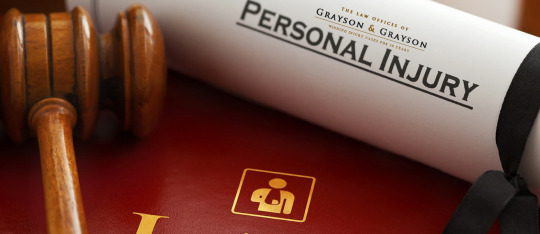










1 note
·
View note
Text
Top 5 Reasons for Dog Bites Liability

Dog bites can lead to serious injuries and legal complexities, particularly when it comes to determining liability. Understanding the reasons for dog bite liability is essential for both dog owners and victims to navigate the aftermath of such incidents effectively. Here are the top five reasons for dog bites liability, providing insight into the legal principles and circumstances that can establish a dog owner's responsibility.
1. Owner Negligence
Negligence is one of the most common grounds for establishing liability in dog bite cases. An owner may be considered negligent if they fail to exercise reasonable care to prevent their dog from injuring others. Examples of owner negligence include:
Lack of Proper Supervision
Unattended Dogs: Leaving a dog unsupervised in an area where it can come into contact with people, such as a park or a front yard without a secure fence.
Inadequate Restraint: Failing to leash a dog in public places where leash laws are in effect.
Ignoring Warning Signs
Previous Aggressive Behavior: If a dog has previously shown signs of aggression and the owner fails to take steps to prevent future incidents, such as by muzzling the dog or providing additional training.
Failure to Heed Warnings: Ignoring recommendations from veterinarians or animal behaviorists regarding the need for behavioral intervention.
2. Strict Liability Statutes
In many jurisdictions, strict liability laws hold dog owners automatically responsible for injuries caused by their dogs, regardless of whether the owner was negligent. Key points about strict liability statutes include:
No Need to Prove Negligence
Automatic Liability: The owner is liable for damages even if they took reasonable steps to prevent the bite.
State Variations: The specifics of strict liability laws can vary by state. For example, some states may only apply strict liability if the bite occurred in a public place or if the victim was legally on private property.
Exceptions
Provocation: The owner may not be liable if the victim provoked the dog.
Trespassing: Owners may be exempt from liability if the bite victim was trespassing on their property at the time of the incident.
3. Violation of Local Laws
Dog owners can also be held liable if they violate local animal control laws, which are designed to protect public safety. These laws often include:
Leash Laws
Leash Requirements: Many municipalities require dogs to be on a leash when in public areas. An owner who lets their dog roam freely in a leash-required zone can be held liable for any bites that occur.
Dangerous Dog Ordinances
Classification of Dangerous Dogs: Some areas have laws that classify certain dogs as dangerous based on their behavior or breed. Owners of such dogs may have additional responsibilities, such as keeping the dog in a secure enclosure or carrying liability insurance.
Failure to Comply: Not adhering to these additional regulations can result in liability if the dog bites someone.
4. Knowledge of Dog’s Dangerous Propensities
An owner can be held liable if they know, or should have known, that their dog has dangerous tendencies. This is often referred to as the "one bite rule," although it doesn’t necessarily require a previous bite incident to apply.
Prior Incidents
Previous Bites: If a dog has bitten someone before, the owner is considered to be on notice of the dog’s dangerous propensities.
Aggressive Behavior: Evidence of past aggressive behavior, such as growling, snapping, or lunging at people, can also establish the owner’s knowledge of the dog’s potential to bite.
Legal Implications
Heightened Duty of Care: Owners aware of their dog’s dangerous propensities are expected to take extra precautions to prevent bites, such as using warning signs, muzzling the dog in public, or providing intensive training.
5. Premises Liability
Premises liability can come into play when a dog bite occurs on the owner’s property. This legal concept typically applies in situations where the owner’s negligence in maintaining a safe environment contributes to the injury.
Invitees and Licensees
Invitees: These are individuals who are invited onto the property for business purposes, such as delivery personnel. Property owners owe a high duty of care to ensure invitees are safe from harm, including from dog bites.
Licensees: These are social guests who are invited for non-business purposes. Owners also owe them a duty of care, though it is slightly less stringent than for invitees.
Trespassers
Limited Duty of Care: Property owners generally owe trespassers a lower duty of care. However, they may still be liable if the trespasser is a child and the owner’s dog is unrestrained and known to be aggressive.
Legal and Financial Consequences
The consequences of dog bite liability can be severe for owners:
Compensatory Damages: These include medical expenses, lost wages, pain and suffering, and any other costs directly related to the injury.
Punitive Damages: In cases of extreme negligence or malicious behavior, the court may award punitive damages to punish the owner and deter future misconduct.
Legal Fees: The owner may be responsible for the victim’s legal fees, depending on the jurisdiction and specifics of the case.
Prevention and Responsibility
To mitigate the risk of liability, dog owners should:
Training and Socialization: Ensure their dogs are well-trained and socialized from a young age.
Adherence to Laws: Follow all local animal control laws, including leash laws and dangerous dog ordinances.
Proper Supervision and Restraint: Always supervise and appropriately restrain their dogs, particularly in public places or around unfamiliar people.
Conclusion
Dog bite liability can arise from a variety of circumstances, including owner negligence, strict liability statutes, violation of local laws, knowledge of the dog’s dangerous propensities, and premises liability. Understanding these reasons can help both dog owners and victims navigate the legal landscape following a dog bite incident. Owners must take proactive steps to prevent bites, ensuring they comply with laws and manage their pets responsibly to avoid legal repercussions. Victims, on the other hand, should seek knowledgeable legal assistance to ensure their rights are protected and they receive fair compensation for their injuries.
0 notes
Text
Sukuna has never said no to you.
It didn’t matter what the request was, simple or complicated, easy to fix or a days-long job, Sukuna was always at your side, completing the task as fast as he needed to to keep you satisfied. He would love to deny it, you’re sure, but evidence proves time and time again that he puts your needs and wants at the top of his priority list.
And you were curious how far you could go with it.
The two of you are sitting in your underwear at the breakfast nook, warming yourselves in the bay window while the morning sun starts on the leftover night time chill. It wasn't quite time for breakfast, still too early for the both of you. In the meantime, you sip on your morning brews, preserving the comfortable silence. Sukuna is flipping through the day's newspaper, his eyes are groggy with sleep and he hasn't said more than a handful of words to you yet. He wasn't a morning person.
You were starting to change that.
"Kuna," You call to him, nudging him with your foot from your corner of the window bench.
"Hmm?" He doesn't look up from the paper, but his hand reaches down and grabs your foot, pulling it into his lap. His thumbs start to subconsciously knead at your muscles.
"I want these." You hold up your phone, which you had previously been scrolling through in an attempt to find something ridiculous for this exact moment. You were sure you had found it, something even Sukuna would find unnecessary.
And yet, he merely glances at your screen, takes in the sight for all of two seconds, and then returns his attention to whatever news article he was in the middle of.
"My wallet's on the counter." He clears the sleep from his throat not sparing a second look.
You blink at him in surprise.
"D-Did you even see what it is?" You flip your phone around to make sure you were displaying the correct thing.
Sukuna is frowning before he looks up again, curious at your persistence. He gently cups your hand, bringing it only a minuscule amount closer to examine your screen a second time.
You were on one of the most luxurious brand’s websites, showing him an incredibly regular pair of panties, no straps, no details, all black- with one of the most outrageous price tags you had ever seen for something so ordinary.
Sukuna cocks a brow at you over your phone, "Can't imagine you need more panties when you're constantly stealing my boxers. But whatever, hand it over. I know my card number-"
"Kuna," You interrupt him with a surprised laugh, holding fast to your phone when he tries to pluck it out of your hands, "they're a thousand dollars."
He glances back, his eyes focusing lower on the screen where you know the price tag to be. The newspaper in his hands drops down, momentarily forgotten by what he sees. For a moment, you think you've found his limit.
"Wait, are those red one's assless?" He points just below the price, where the recommended products are depicted. "Get those too."
You drop the phone down so that he meets your eyes, which are wide with shock.
Sukuna always took care of you. Always insisted on being the provider of any single thing that you may need; a warm meal, a soft bed, anything your eyes twinkled at that was available for purchase- even if you would never think of buying or owning it. Granted, you never wanted much in terms of material possessions, so you didn't realize the true extent of Sukuna's leniency until now.
It was slightly intimidating, and part of it felt wrong. Sukuna had money, plenty of it, but that didn’t mean he should feel the need to spend copious amounts of it on you just because you could ask him to. He was giving you too much power, it felt like.
You huff through your nose, frowning at him, which only has him tilting his head further to the side in question.
You ignore it, setting your phone onto the window seat and crawling your way closer to him, until you can gather up his face in your hands and lock his gaze into yours.
He glares at you past smushed cheeks, but doesn't make a move to break free of your hold, humoring you. "The hell are you doing-"
"You know you don't always have to say yes to me?"
Now that has him taken aback. His mouth automatically opens for a witty response, but your question seems to have effectively taken the words from his mouth. You can see the cogs in his head turning, and what you wouldn't give to peer inside his mind and hear his thoughts.
It takes him a moment, but eventually that familiar confident smile stretches across his sleepy face. His hands seem to instinctively slide their way up your bare legs until his fingers grip your hip bones, pressing into you.
He hums, "When have you ever said no to me?"
You scoff, ready to give him a prime example, but end up coming up short. The two of you loved to tease each other with disobedience, but in the end you were eager to give Sukuna anything his heart desired. You loved to please him, it was one of your favorite things to do, in fact.
"You never ask anything ridiculous of me." You remind him, smiling as one of his warm hands slides back down your waist and dips into the pair of his boxers you were sporting that day.
"You know what's ridiculous?” His voice wraps around your throat, and suddenly has you swallowing past the delicious grip. You're folding into him before you even realize it, at the mercy of his calloused hands. "The implication that I wouldn't do just about anything for you."
You can't help but sigh hopelessly, although it comes out as a desperate noise that pleads him for more. You really were all his, just like he loved to tell you.
"Now hand me your phone." It's a whisper, coaxing you. "I wanna see you in red."
You can’t say no.
At least it was mutual.
#jjk#jjk x reader#sukuna x reader#sukuna#ryomen sukuna#kuna is a feral dog in the eyes of anyone that isn't you#you bring out the puppy love in this psycho#careful#he bites#this was a short and sweet#fluff
9K notes
·
View notes
Note
I'm very disappointed that you would reblog posts about pitbulls. The "nanny dog" thing is a myth, and they account for nearly 70% of all fatal dog attacks in the USA. It sucks and it's not fair for the dogs, but they were bred to be aggressive. It feels like when someone "tames" a bear cub and is later mauled. It's simply in their nature. And no, I don't care that anecdotally all pitbulls you've met were sweet and kind. Many owners have been killed by their very own sweet pitbulls. It's not ALL pitbulls, but isn't it funny how 70% of the time it's a pitbull?
THIS?????

YOU'RE MAD ABOUT THIS???????
unfollow me right now. I'm genuinely serious.
if you're this eager to believe cop statistics about scary dogs, what the fuck do you believe about other animals?? do you also think sharks are mindless eating machines that want to launch themselves onto the beach after you?? no it's not 'in its nature' or whatever the fuck, do you think it's a jurassic park velociraptor or something?? it's a DOG.
I've posted about this before, but pitbulls are just another type of large-breed dog with breed-specific needs and behaviors that make them not suitable for every home, but by and large they're about the same as every other dog in their size class.
german shepards, malonois, hell, even labs and goldens will maul adults and kill kids if not correctly trained or mistreated! all large dogs are inherently somewhat dangerous and should be trained and treated accordingly, which sadly MANY owners do not. PITS. ARE. NOT. SPECIAL.
#spoiler alert: any dog is a pitbull if the police don't care enough#and they don't. my previous post had people in the notes who witnessed cops logging attacks from non-pit dogs as from pits#because they are incentivized to record pitbull bites even if it's a golden retriever#pitbull discourse
2K notes
·
View notes